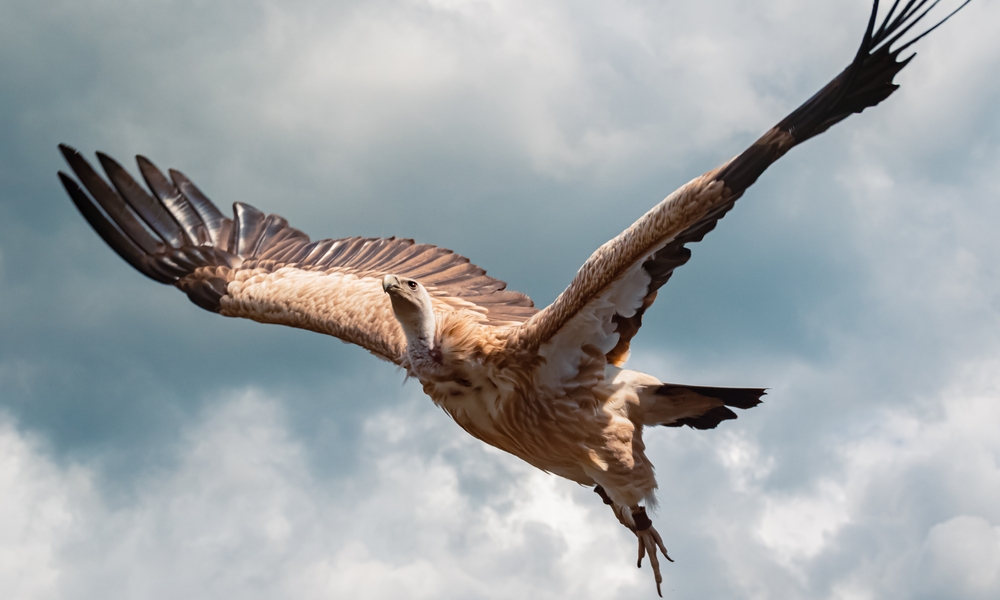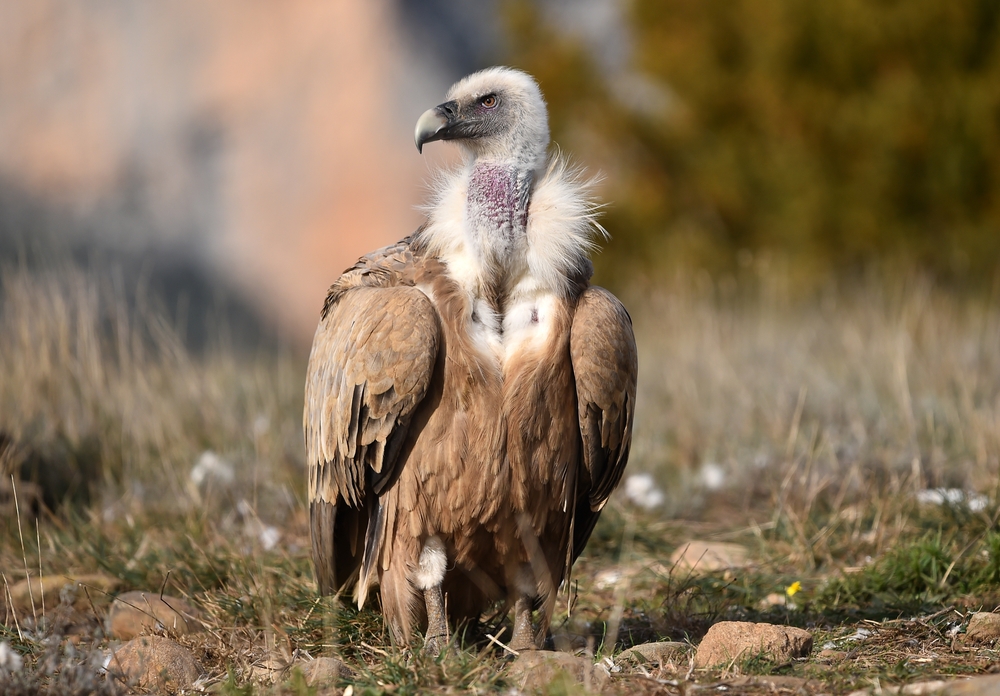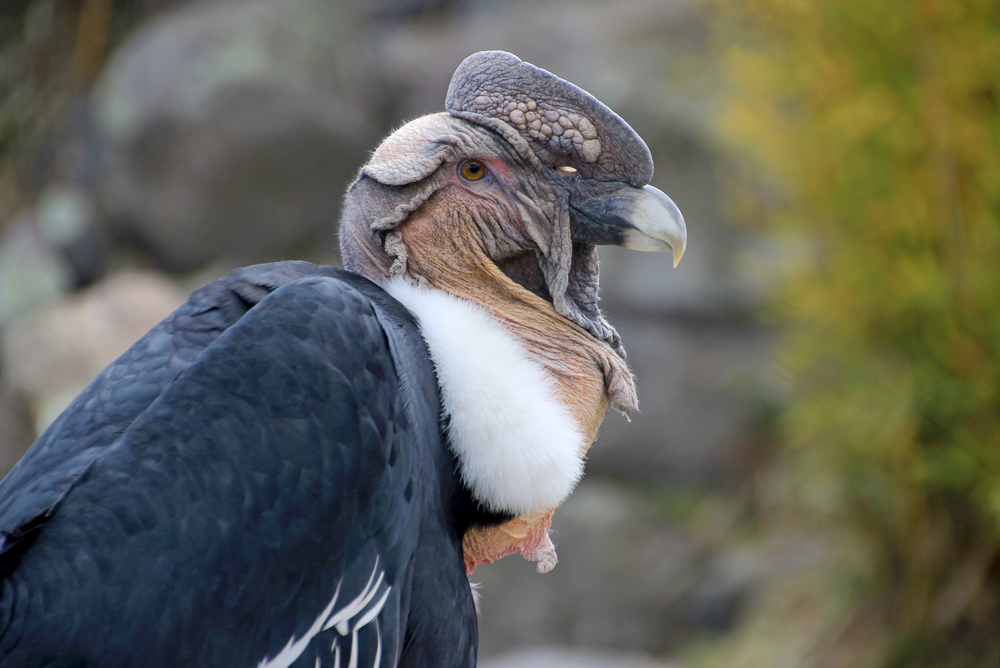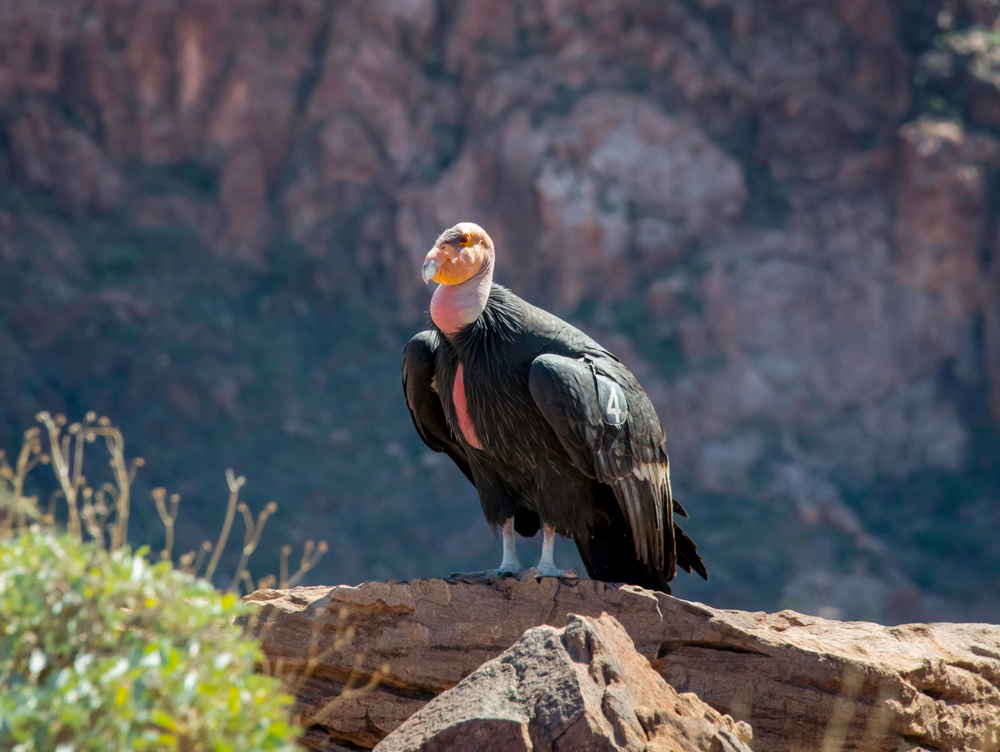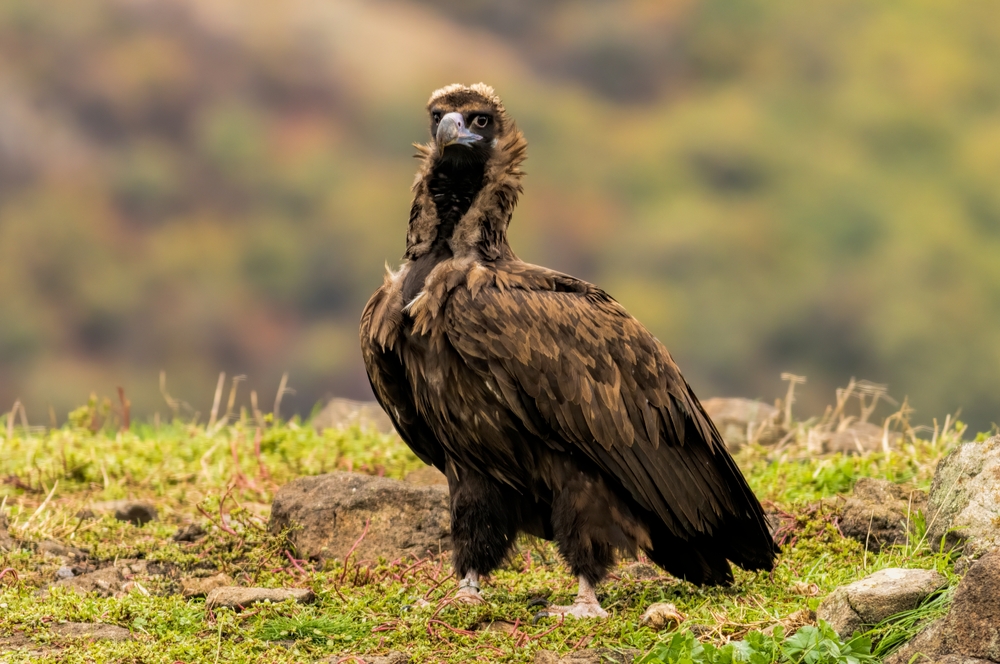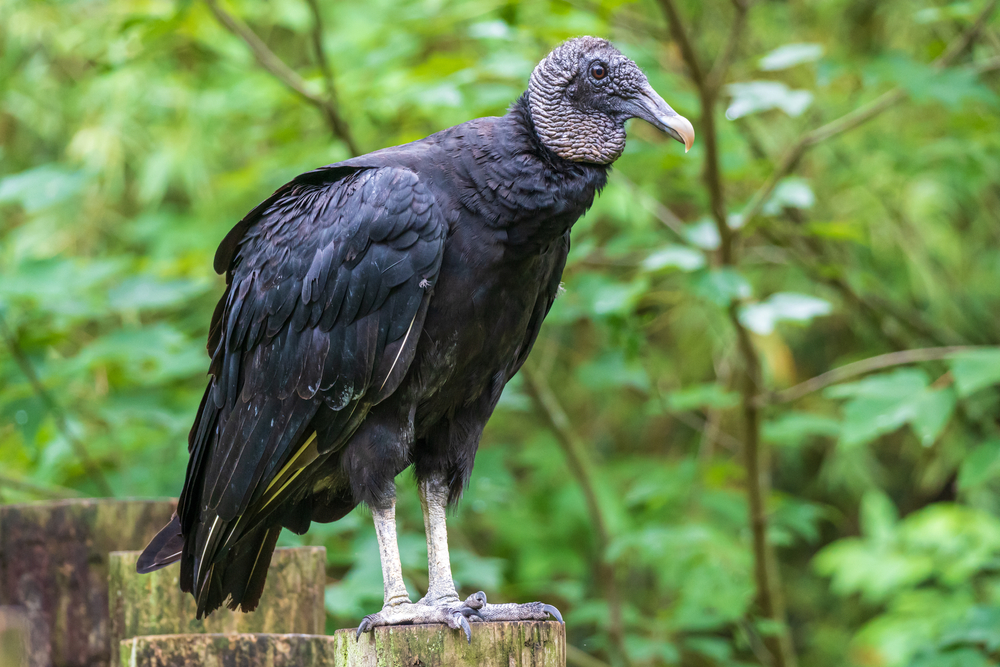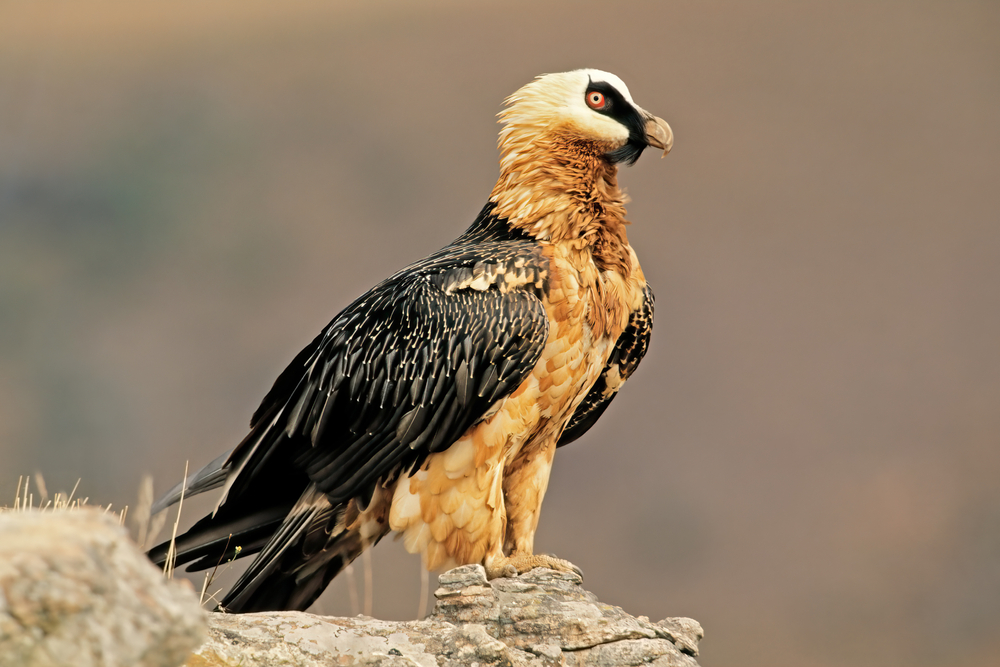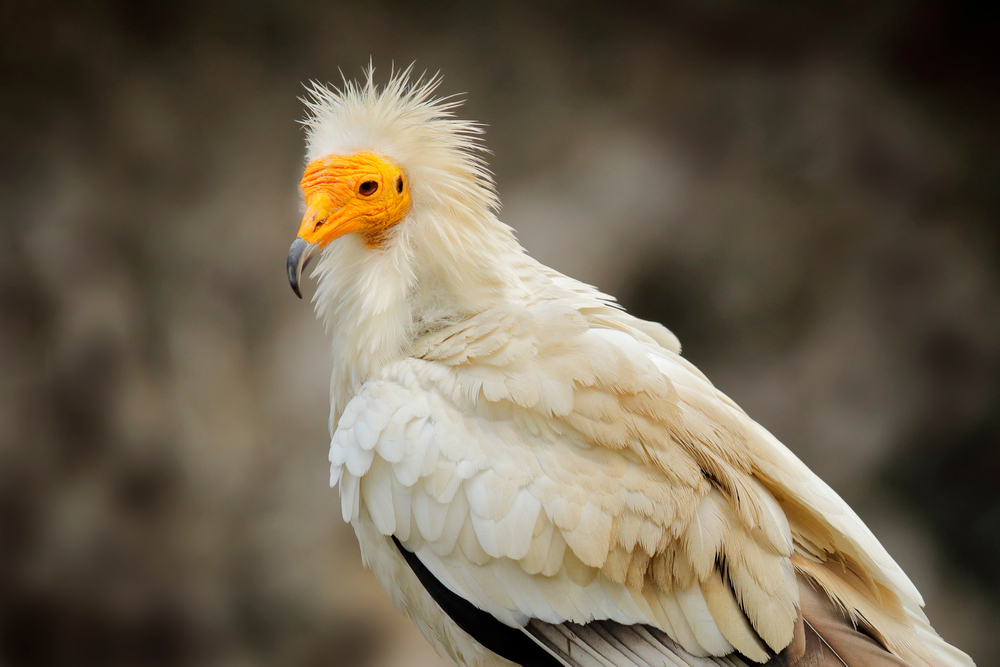The Himalayan Vulture (Gyps himalayensis) is most closely related to the Griffon Vulture (Gyps fulvus), with which it shares similar appearance and behavior. Some experts consider it a high-altitude counterpart of the Griffon.
About
The Himalayan Vulture (Gyps himalayensis), also known as the Himalayan Griffon, is a massive Old World vulture of the Accipitridae family. Native to the high mountain ranges of Central Asia, including the Himalayas and Tibetan Plateau, it is one of the largest flying birds in the world, adapted to survive at extreme altitudes where few other scavengers can thrive.
This vulture is strikingly large, with a wingspan of 2.6–3.1 meters (8.5–10.2 ft) and a weight of 8–12 kg (18–26 lbs). It has a pale buff body, darker flight feathers, and a whitish head and neck covered in down. A thick, pale ruff of feathers circles the base of its neck, helping it retain warmth in frigid high-altitude climates. Its broad wings and strong soaring ability allow it to ride powerful mountain thermals with minimal effort, often gliding above peaks exceeding 7,000 meters (23,000 ft).
As an obligate scavenger, the Himalayan Vulture feeds almost entirely on carrion, particularly the remains of domestic livestock, wild ungulates, and other large mammals. Its long neck enables it to reach deep inside carcasses, while its strong bill tears through flesh and hide. By cleaning up carrion in remote regions, it plays a crucial role in maintaining the health of mountain ecosystems.
Breeding usually occurs on cliffs and crags, where pairs construct large stick nests. The female typically lays a single egg, and both parents share incubation duties over a period of about two months. The chick fledges after several months but remains dependent for additional time.
Although considered Near Threatened, the Himalayan Vulture faces significant challenges from poisoning (particularly through ingestion of veterinary drugs like diclofenac in livestock carcasses), habitat disturbance, and food shortages. Conservation efforts focus on reducing poisoning risks and raising awareness of its ecological importance.
Physical Characteristics
The Himalayan Vulture (Gyps himalayensis), also called the Himalayan Griffon, is one of the largest Old World vultures, adapted to soaring in the world’s highest mountains.
Plumage:
-
Adults: Pale buff to cream body with contrasting dark brown flight feathers and tail. A whitish ruff of feathers surrounds the neck base.
-
Juveniles: Darker brown overall, gradually lightening with age until they resemble the pale adults.
Head and Face:
The head and neck are bare with pale down covering parts of the skin. The beak is long, hooked, and ivory-colored, suited for tearing carrion. The long, bare neck allows the bird to feed deep inside carcasses.
Body and Wings:
A bulky body with exceptionally broad wings designed for soaring. The underwings show pale coverts with darker edges, making them recognizable in flight. Their powerful wing structure allows them to glide efficiently in thin mountain air.
Tail:
Short and squared, helping with maneuverability when soaring along cliffs and mountain ridges.
Size:
-
Length: 41–50 in (103–127 cm)
-
Wingspan: 8.5–10.2 ft (2.6–3.1 m)
-
Height at Rest: About 3.6 ft (1.1 m) when standing
Weight:
-
Adults: 18–26 lbs (8–12 kg), with females slightly larger than males.
The Himalayan Vulture’s immense size, pale body with dark flight feathers, and high-altitude soaring ability make it one of the most impressive vultures. Perfectly adapted for life at 3,000–5,500 m (9,800–18,000 ft), it is a dominant scavenger of the world’s highest ecosystems.
Reproduction
The Himalayan Vulture (Gyps himalayensis) breeds at high altitudes, with a reproductive cycle that is slow and similar to other large Old World vultures.
1. Mating and Courtship:
Pairs are monogamous, often bonding for life. Courtship includes aerial displays, synchronized circling, and mutual preening at cliffside nest sites.
2. Nesting Sites:
They build large stick nests on steep cliffs, rocky crags, or inaccessible ledges, usually at elevations of 3,000–5,000 m (9,800–16,400 ft). Nests are reused year after year, expanding with each season.
3. Egg Laying:
The female lays a single egg per clutch, typically between January and March, timed so that chicks fledge before the summer monsoon season. The egg is white with occasional faint markings.
4. Incubation:
Incubation lasts about 54–58 days, with both parents sharing duties, though the female often spends more time on the nest.
5. Hatching and Care of Chicks:
Chicks hatch covered in white down and are entirely dependent on their parents. Both parents regurgitate food to feed the chick, often traveling long distances to locate carrion.
6. Fledging and Independence:
Young fledge at about 4–5 months old, but may remain dependent on parents for several additional months as they learn to soar and forage in mountain terrain.
7. Breeding Frequency:
Pairs typically raise one chick per year, though failed attempts may prevent breeding until the following season.
The Himalayan Vulture’s slow reproduction, reliance on remote cliff nests, and single-egg clutches reflect its adaptation to the harsh but stable ecosystems of the high mountains.
Lifespan
The Himalayan Vulture (Gyps himalayensis) is a long-lived scavenger, with survival shaped by its slow reproductive rate and harsh mountain environment.
Lifespan in the Wild:
In the wild, Himalayan Vultures typically live 20–25 years, though some may reach 30–35 years under favorable conditions. Survival rates are lower for juveniles due to starvation, falls from cliffs, and predation.
Lifespan in Captivity:
In captivity, with reliable food and veterinary care, individuals may live 40–45 years, similar to other large vultures.
Threats to the Himalayan Vulture:
-
Poisoning: Ingestion of poisoned carcasses, including those laced with pesticides to kill predators.
-
Veterinary Drugs: Exposure to diclofenac (an anti-inflammatory drug used in livestock) is a major cause of vulture declines in South Asia.
-
Food Shortages: Declines in livestock carcasses due to changes in pastoral practices.
-
Collisions: Increasing risk from power lines in mountain valleys.
-
Natural Risks: Harsh climate, thin air, and long flights across high-altitude ranges increase mortality risk for young vultures.
The Himalayan Vulture’s longevity and dominance at carcasses are balanced by its vulnerability to poisoning and its extremely low reproductive rate, making protection of adult survival key to conservation.
Eating Habits
The Himalayan Vulture (Gyps himalayensis) is a specialized scavenger, adapted to finding and consuming carrion in the high mountains where few other scavengers can survive.
Diet:
-
Large Mammal Carrion: Primarily feeds on carcasses of domestic livestock such as yaks, goats, and sheep, as well as wild ungulates like bharal (blue sheep) and Himalayan tahr.
-
Occasional Smaller Carcasses: Consumes medium-sized mammals, birds, and other animals when available.
-
Scraps: Will feed on skin, tendons, and bones left behind after other scavengers have eaten softer tissues.
Hunting Strategy:
-
Soaring Search: Uses powerful wings to soar on thermals above mountain valleys, scanning for carcasses.
-
Group Feeding: Often gathers in numbers at carcasses, with social hierarchies determining which birds feed first.
-
Reliance on Visibility: Like other Gyps vultures, it locates food mainly through sight rather than smell.
Feeding Behavior:
-
Equipped with a strong bill capable of tearing into hides and muscles.
-
Often arrives at carcasses in large groups, where dominance hierarchies decide feeding order.
-
Can gorge on several pounds of carrion in one sitting, then go days without food.
-
Bare head and neck prevent fouling while feeding deep in carcasses.
Success and Adaptability:
The Himalayan Vulture’s soaring ability, dominance at carcasses, and tolerance of thin mountain air make it one of the most effective high-altitude scavengers. However, its dependence on livestock carcasses and vulnerability to toxins threaten its long-term survival.
Uniqueness
The Himalayan Vulture (Gyps himalayensis), also called the Himalayan Griffon, is one of the most distinctive vultures in the world, shaped by life at extreme altitudes.
Largest of the Gyps Vultures:
With a wingspan of up to 10 ft (3.1 m), it is one of the largest Old World vultures, rivaling the Cinereous Vulture in size.
High-Altitude Specialist:
Adapted to soar at 3,000–5,500 m (9,800–18,000 ft), it thrives in thin mountain air where few other scavengers can survive.
Pale Plumage for High Mountains:
Its buff-colored body and contrasting dark wings provide camouflage among cliffs and rocky slopes of the Himalayas.
Social Feeder:
Though massive, it often gathers in large groups at carcasses, relying on social feeding strategies similar to other Gyps vultures.
Ecological Role in Pastoral Societies:
Vital for clearing livestock carcasses in high mountain communities, preventing the spread of disease and maintaining ecological balance.
Cultural Significance:
In Himalayan cultures, it is linked to sky burial traditions, where vultures consume human remains as part of sacred funerary practices, highlighting its spiritual importance.
The Himalayan Vulture’s immense size, high-altitude mastery, and cultural role make it one of the most unique and iconic vultures of Asia.
Be the First to Share Photos of This Species.
FAQ’s
1. What species is closest to the Himalayan Vulture?
2. How does the Himalayan Vulture compare to other vultures?
The Himalayan Vulture is one of the largest of all Old World vultures, rivaling the Cinereous Vulture in size. Unlike the Bearded Vulture, which specializes in bone consumption, the Himalayan Vulture feeds mainly on flesh and soft tissue. Compared to the Egyptian Vulture, it is far less versatile but dominates carcasses through size and strength.
3. What national parks provide the best opportunity to see a Himalayan Vulture?
What national parks provide the best opportunity to see a Himalayan Vulture?
-
Sagarmatha National Park (Nepal): Frequently seen soaring near Mount Everest.
-
Langtang National Park (Nepal): Common along high-altitude valleys.
-
Hemis National Park (India): A reliable location in Ladakh.
-
Jigme Dorji National Park (Bhutan): Good viewing opportunities in Himalayan ranges.
-
Qomolangma National Nature Preserve (Tibet): A key site for observing high-altitude scavengers.



































































